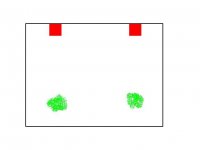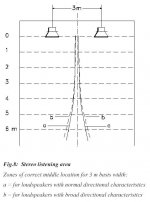Originally posted by WithTarragon The basic finding (and do not start criticizing until you have actually read and digested the material) is that a "phantom" source is in fact "identical" to a what would be created via stereophony (using two speakers). He provided a phasor analysis (if I recall correctly) for the physics behind this.
Maybe my english isn't good enough and I don't understand the point you want to make but what you describe is the definition of a phantom source: two or more coherent sound signals within 1 ms fuse to one sound sensation. But this is not a physical process but something that our brain accomplishes.
Elias said:
Meaning if you place high freq sources in or very close to the frontal median plane, high freqs emitting from these sources do not disturb other localisation cues that may take place at the same time.
One famous implementation of this: Ambiophonics.
one less known - Stereolith and Stereolith-like set up
Elias said:
I think you are wishing too much. I would be happy even for ONE stable phantom source under reverberant conditions
why?
speaking of reverberant conditions I mean normal living/listening room conditions (RT60 around 0.2-0.5)
certainly not gothic cathedral echoes
so why not?
best!
graaf
WithTarragon said:
The basic finding (and do not start criticizing until you have actually read and digested the material) is that a "phantom" source is in fact "identical" to a what would be created via stereophony (using two speakers). He provided a phasor analysis (if I recall correctly) for the physics behind this.
I don't understand it either
what do You mean by saying " "phantom" source is in fact "identical" to a what would be created via stereophony (using two speakers)"?
WithTarragon said:
The other topic you guys mentioned was localization and localization with echoes/reverberation etc. The rules don't fundamentally change regarding the role of interaual cues.
Do You mean that reverberation is not detrimental to imaging (understood as localization of phantom stereophonic sources)?
could You please explain?
best regards!
graaf
el`Ol said:I found the sweet spots for listening to synthetic productions with Carlsson speakers. They exactly form a square with the speakers. Finally a northern concept for us trolls
so extremely off axis?
surprising!
I wonder what is the operating principle of this
best regards!
graaf
el`Ol said:I found the sweet spots for listening to synthetic productions with Carlsson speakers. They exactly form a square with the speakers. Finally a northern concept for us trolls
I originally posted it in "Loudspeaker perception" thread but the fact is that it is no longer "stereo imaging" thread and nobody seems to be interested in discussion these issues
anyway, continuing the question of "sweet spot" (aka "stereo listening area")
The stereo listening area is very narrow. For a basis width of 3 m, the listening area at a listener's distance of 3 m is only 21 cm wide (for loudspeakers with normal directional characteristics).
At 5 m distance it is only 38 cm wide (reverberation time about 0,5 s). For a larger basis width the listening area is even narrower. Loudspeakers with a larger radiation angle (spherical loudspeakers) increase the width of the stereo listening area by a factor of about 1,5; they have, however, the disadvantage of reduced sharpness of localization.
see: http://www9.dw-world.de/rtc/infothe...sound_perc.html
what can be explanation for this?
I mean "increase the width of the stereo listening area" with "loudspeakers with a larger radiation angle"?
on the other hand - have You experienced "reduced sharpness of localization" in Your extremely asymmetrical listening positions with Carlssons? if yes then how significant?
best regards!
graaf
Attachments
When I listen to synthetic productions in the usual positions everything happens within two straight lines through my head and the speakers, so classic pingpong stereo, but with a sense of depth. Even the two perceived rooms are one-dimensional. Only the square position does a proper fusion of the two tunnels to a real three-dimensional room. There still happens less in the center, but this doesn´t sound un-realistic.
graaf said:I see but what about imaging? "sharpness of localization"?
is it diminished? are there realistic phantom images?
No, in this respect the synthetic productions are still far behind the "real" ones. With synth productions the CFS is ahead in this respect. Me, and probably most of us, set the realism of the performers over the realism of the room, so still a recommendation of the CFS for pop/rock music.
el`Ol said:
No, in this respect the synthetic productions are still far behind the "real" ones. With synth productions the CFS is ahead in this respect. Me, and probably most of us, set the realism of the performers over the realism of the room, so still a recommendation of the CFS for pop/rock music.
what about imaging with Carlssons with "real productions"?
what about imaging with CFS? which is a kind of "loudspeaker with a larger radiation angle" in the meaning used in Infotheque, quoted above
the link once again:
http://www9.dw-world.de/rtc/infotheque/sound_perception/sound_perc-content.html
best!
graaf
With real stereo-recordings the radiation angle of the Carlsson is very wide, but the imaging remains sharp. With synthetic reverb production it is the other way round: very narrow sweet-spot (the mentioned square) and more diffuse imaging. The CFS has a wide radiation angle as well. It has a slightly less sharp imaging, but still the reach out and touch effect. As mentioned the impulse response of the reflected signal is important. Synthetic productions have a large radiation angle as well, but impaired realism of the image that is clearly ahead of the Carlsson, however.
As mentioned only the Carlsson gives the feeling of being in a real room.
As mentioned only the Carlsson gives the feeling of being in a real room.
I'm always wondering what "real" means? Have you ever been in the concert hall where the original sound recording took place? If yes, have you ever changed seats and experienced how the sound changes? Have you ever heard what the mixing engineer made of this recording in his control room?
For me there's only more or less spaciousness and envelopment. As there are no standardized setups for control and listening rooms, this discussion here of "real" or "right and wrong" doesn't make much sense at all.
Best, Markus
For me there's only more or less spaciousness and envelopment. As there are no standardized setups for control and listening rooms, this discussion here of "real" or "right and wrong" doesn't make much sense at all.
Best, Markus
I guess "real" room means, that one has a feeling of being in another room than the one he actually is in - at least that is what I consider "being in a real room". It does not mean anything true to reality for me - Markus pointed out, that I really do not know the reality. I experimented very little with adding artificial reverb to rock recordings - with very unsatisfactory results. It only worked on my e-guitar dry signal - then I really felt the same way as if I played in a small garage or cathedral - even with a small open-backed combo amp (mono).
pelanj said:I guess "real" room means, that one has a feeling of being in another room than the one he actually is in
exactly, nothing more and - of course - nothing less
an illusion
best regards!
graaf
markus76 said:
Have you ever been in the concert hall where the original sound recording took place? If yes, have you ever changed seats and experienced how the sound changes?
Usually I don´t get the opportunity to wander around during a concert

Wandering in the listening room with a Carlsson setup should be avoided. When I shift towards the side the performers shift with me, while the room stays where it is. But, as said quite at the begining of the thread (or was it an other one, unfortunately there are too much of that sort) the goal is the maximum "you are there feeling", not getting as much information out of the recording as possible.
And as you use the word "envelopment": It is an envelopment I find "acoustic", whereas I perceive the envelopment of a reverb device as psychedelic.
The psychedelic effect of these recordings is reduced when listening to them in the "Carlsson Square" instead of a conventional setup, but at the expense that the performers are becoming big and diffuse.
The psychedelic effect of these recordings is reduced when listening to them in the "Carlsson Square" instead of a conventional setup, but at the expense that the performers are becoming big and diffuse.
Originally posted by el`Ol the goal is the maximum "you are there feeling", not getting as much information out of the recording as possible.
Then you should switch to multichannel NOW. Only more speakers can generate the reflections necessary for more inartificial spaciousness and envelopment. This is simply because these reflections need to be of a certain level, delay and direction.
markus76 said:
Then you should switch to multichannel NOW. Only more speakers can generate the reflections necessary for more inartificial spaciousness and envelopment. This is simply because the reflections need to be of a certain level, delay and direction.
Well, if I was Ralph Glasgal and had the money for tons of speakers and DSPs, maybe. The only highend 5-channel system I have listened to was a system with 7 Mangers: 2xdipole, 1xmonopole L+R, 2xradial L-R, R-L, and I wasn´t impressed. The owner didn´t have a 5-Channel player at that time, so I can´t say how multichannel sounds with that system. But as far as I know there isn´t even an accepted standard for "real acoustic" multichannel recordings, some exhumated the Decca Tree...
markus76 said:Well, listening to a multichannel system without a multichannel signal is sort of ... pointless?
But as there's no standard for stereo either I would give it a try.
there is a standard for stereo - intensity stereo - XY, MS or panpotted
as to AB stereo:
Due to compatibility problems, delay time stereophony is rarely used.
see: http://www9.dw-world.de/rtc/infotheque/stereo/stereo_recording.pdf
or are they wrong?
best regards!
graaf
- Home
- Loudspeakers
- Multi-Way
- The Advantages of Floor Coupled Up-Firing Speakers

